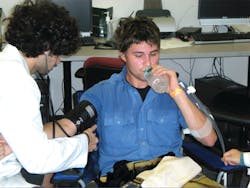Firefighters wear structural turnout gear and other components of personal protective equipment (PPE) to provide protection against multiple hazards, most notably thermal injury. The use of such protection is absolutely necessary, but it also imposes a physiological burden. Specifically, the weight and insulative properties of the gear increase the cardiovascular and thermoregulatory strain of performing work.
National Fire Protection Association (NFPA) 1971, Standard on Protective Ensembles for Structural Firefighting and Proximity Firefighting, includes a thermal protection performance (TPP) test to ensure a minimum amount of thermal protection as well as a total heat loss (THL) test to ensure minimum level of heat dissipation. However, current NFPA standards for TPP and THL consider only the turnout gear worn during emergency operations. In fact, the clothing worn under the turnout gear (including base layers and station uniform) may also contribute to thermal protection and may limit heat dissipation.
Effects of stationwear
There is currently no standard practice in the United States as to the clothing worn under structural turnout gear. Many firefighters wear a cotton T-shirt issued by the department. Some departments also require that firefighters wear a station uniform shirt over the cotton T-shirt, although this may only be required during “business hours.”
Although wearing a station uniform shirt may be desirable for the sake of tradition and professionalism, it is not known if the station uniform shirt has beneficial or detrimental effects on physiological response or comfort during work. Previous research has shown that adding clothing layers in athletic and military settings increases thermal stress by increasing thermal insulation and decreasing evaporative cooling efficiency. However, increasing layers may also increase protection against thermal injury, thus being of some benefit to firefighters.
In order to understand the influence of wearing a station shirt, we performed a research study that included both human performance and materials performance testing. For both types of testing, we considered all layers of the clothing worn by the firefighter (baselayer, station uniform, structural turnout gear) as an integrated clothing ensemble.
Ten male participants participated in the human performance testing component of the research study. Testing was done in a thermoneutral laboratory (69.8 degrees Fahrenheit; 58.0% relative humidity). On different days, participants wore station pants and either a cotton T-shirt alone (511 Tactical Services, Modesto, CA; weight, 6.81 ounces; thickness, 0.022 inches) or a cotton T-shirt AND a short-sleeved station uniform shirt (Topps Safety Apparel, Rochester, NY; weight, 4.37 ounces; thickness, 0.017 inches; NOMEX) under full firefighting personal protective equipment (PPE; G-XTEME turnout pants and jacket Globe Manufacturing Co., Pittsfield, NH; weight, 20.57 ounces; thickness, 0.084 inches; outer shell, GEMINI PBI Matrix; moisture barrier, CROSSTECH 2C; thermal barrier, QUANTUM3D two-layer). Participants also wore other protective equipment, including boots, flash hood, helmet, gloves and self-contained breathing apparatus (SCBA) during an alternating work/recovery protocol lasting 110 minutes.
Exercise protocol
A 110-minute alternating work/recovery protocol consisting of three 20-minute bouts of work, with bouts separated by recovery periods of 10, 20 and 20 minutes, was used to mimic a realistic work cycle for firefighters. Work entailed walking on a treadmill at a moderate intensity level (~70% of age-predicted maximal heart rate) while wearing PPE. Personal protective equipment was doffed and a fan was used to cool participants during the recovery periods to mimic recommendations during planned cooling periods of emergency operations.
Measurements
Measures of physiological and perceptual strain were assessed during both work and recovery. Heart rate, body temperature (measured with an ingestible pill) and chest skin temperature were measured throughout the protocol to characterize physiological strain. Additionally, participants rated their thermal sensations (“unbearably cold” to “unbearably hot”) and perceived exertion level (“not tired at all” to “so tired, I can’t go anymore”) using standardized scales. Participants also rated clothing sensations such as comfort, coolness/hotness and wetness following the third exercise bout. Sweat loss and sweat absorbed by the clothing over the course of the protocol were calculated.
Clothing ensembles were compared by examining the differences in measures of strain over the individual exercise bouts and recovery periods. For example, if heart rate was 70 beats/minute at the start of exercise and 140 beats/minute at the end of exercise, the difference of 70 beats/minute was the value used for comparison purposes.
Results
As expected, all measures of strain increased during exercise and decreased during recovery. Heart rate (Figure 2), body temperature (Figure 3), chest skin temperature (Figure 4) and rating of perceived exertion (Figure 5) reached similar levels during exercise when the station shirt was worn and when it was not. The change in heart rate during Exercise 2 was greater when wearing only the cotton T-shirt under turnout gear, but this was due to starting at a lower heart rate at the beginning of the exercise session rather than reaching a higher peak heart rate. The change in thermal sensations was slightly higher during the first exercise bout when the station uniform shirt was worn (Figure 6).
During all three recovery periods, chest skin temperature dropped more (7.13-11.93 degrees F vs. 3.10-5.15 degrees F) when the station uniform shirt was not worn. However, the difference in chest skin temperature was not maintained, as chest skin temperature reached the same levels for both ensembles by the end of the subsequent exercise bouts. Additionally, there were no differences in sweat loss or sweat retained by the clothing between ensembles for either measure. Similarly, no differences in clothing sensations between the ensembles were reported.
Materials performance testing
The second component of the research study, materials performance testing, was performed in accordance with NFPA standards. For each configuration examined, three tests were run. The TPP rating of 42.3 cal/cm2 for the G-XTREME turnout gear alone is the TPP rating reported in standard TPP tests of firefighting turnout gear. Both ensembles that included clothing layer under the turnout gear provided greater thermal protection than turnout gear alone (56.4 cal/cm2 and 64.8 cal/cm2 for the two- and three-layer ensembles, respectively; Figure 7). When assessing THL, both ensembles that included clothing layers worn under the turnout gear had lower THL ratings than turnout gear alone (Figure 8). However, the ensembles that included clothing worn under the turnout gear did not differ from each other (TOG: 266 W/m2; 2-layer: 235 W/m2; 3-layer: 241 W/m2), suggesting that the addition of the station uniform did not interfere with THL in the material performance test.
Conclusions
This study shows that the levels of cardiovascular, thermoregulatory and perceptual strain experienced during intermittent moderate-intensity work/recovery work bouts were similar whether wearing a cotton T-shirt alone or in combination with a station uniform shirt under structural turnout gear. In contrast, chest skin temperature during recovery periods was lower when not wearing the station uniform shirt in our study, which used a fan to actively cool firefighters during our protocol.
Materials performance testing indicated that the addition of a station uniform shirt increased thermal protection without imposing greater thermal strain (THL was similar) compared to just wearing a cotton t-shirt under the turnout gear.
In summary, considering the layers of clothing worn under structural firefighting gear is important to understand the thermal protection provided and the physiological burden imposed by the total clothing ensemble. We conclude that during intermittent work (with active cooling in a thermoneutral environment) there is no detrimental effect of wearing a station uniform shirt and that there may be an increase in thermal protection around the upper body when a station uniform is worn. These findings, along with other concerns such as tradition and professionalism, should be considered when decisions are made about the use of station uniform shirts.





